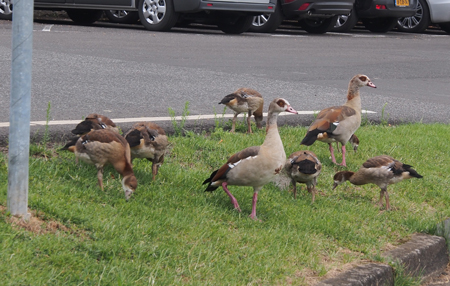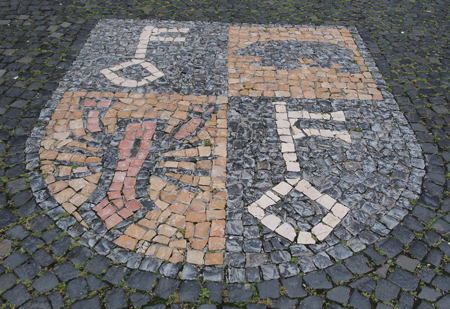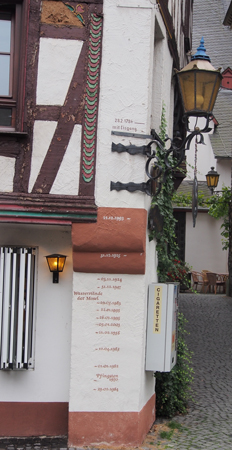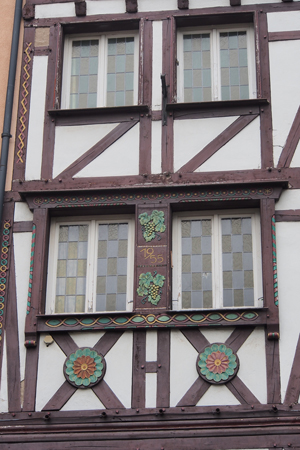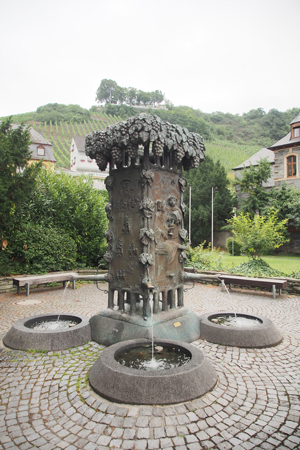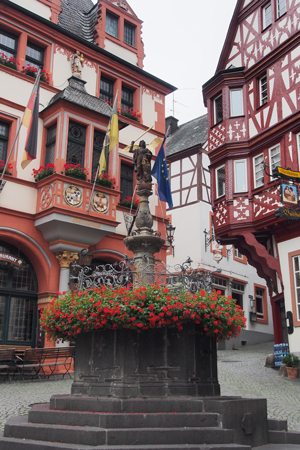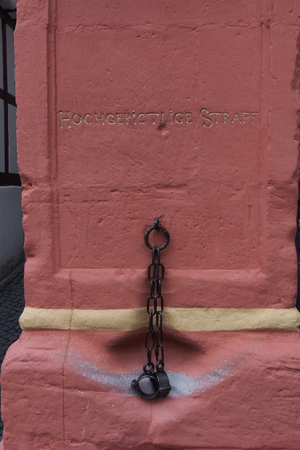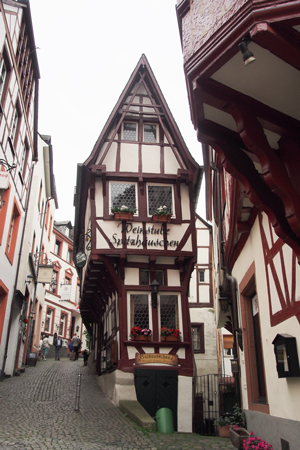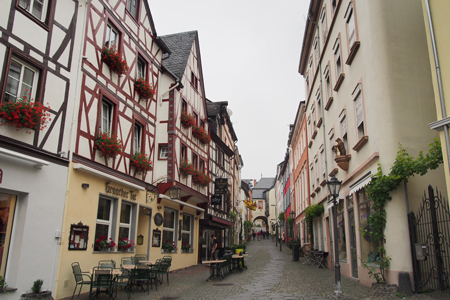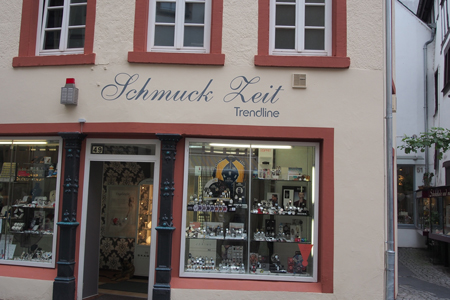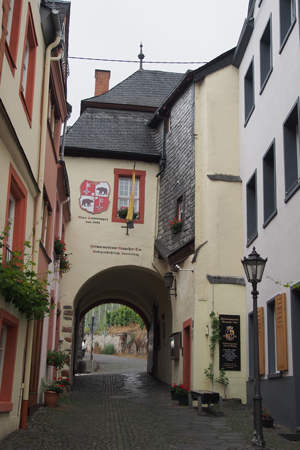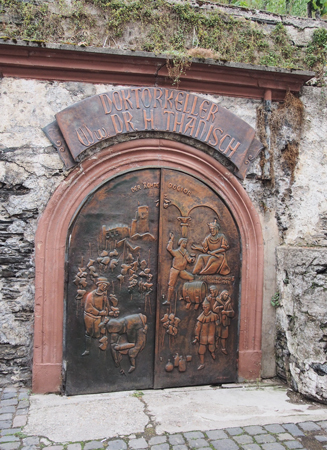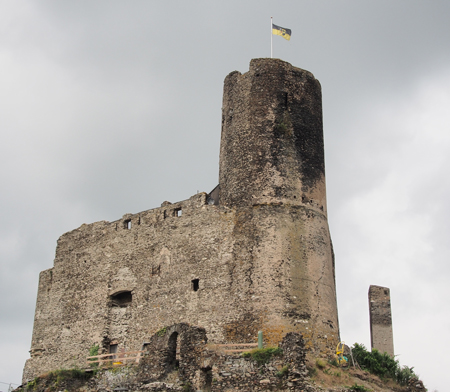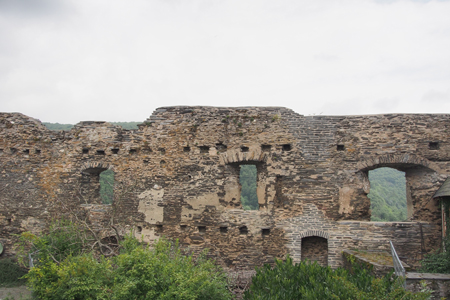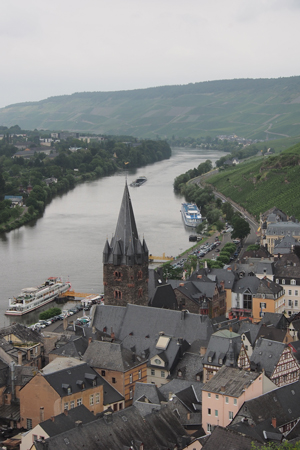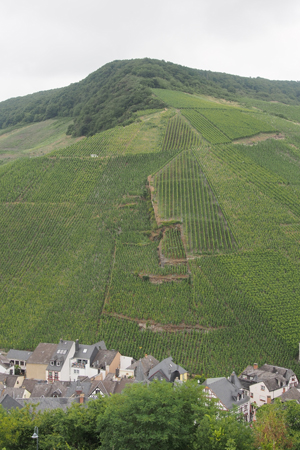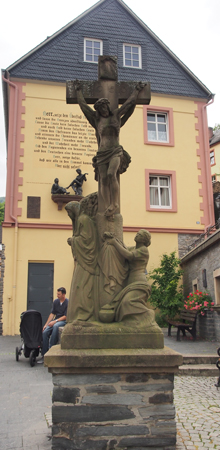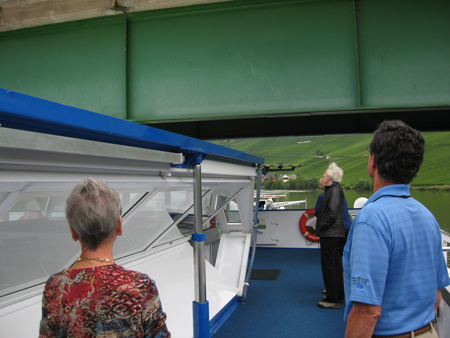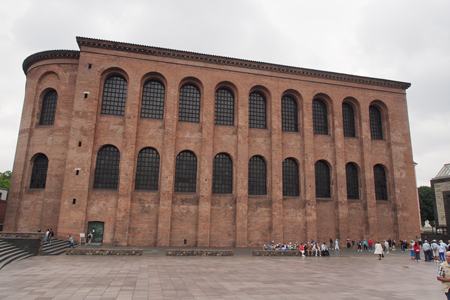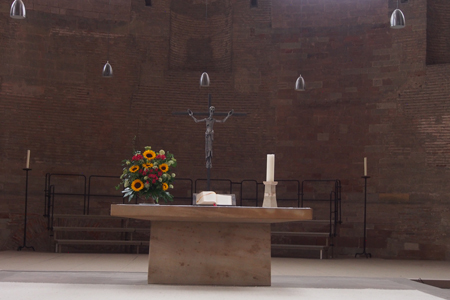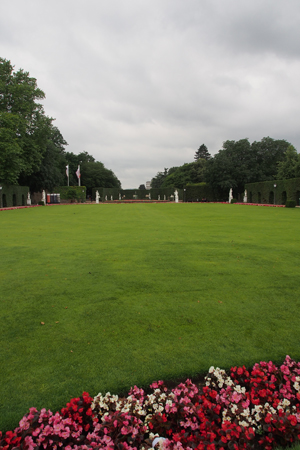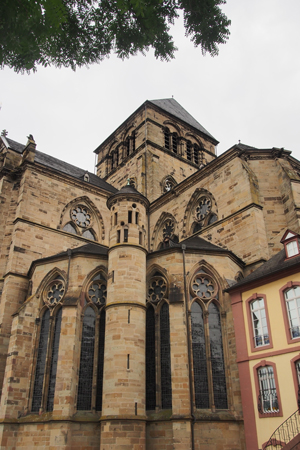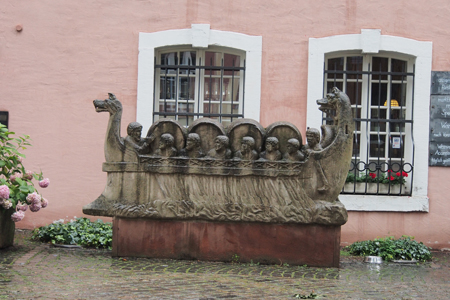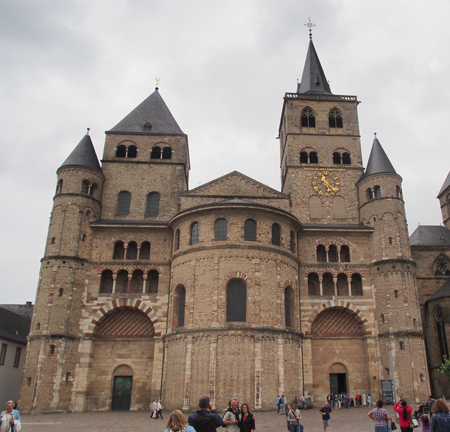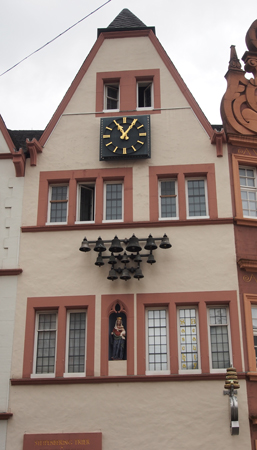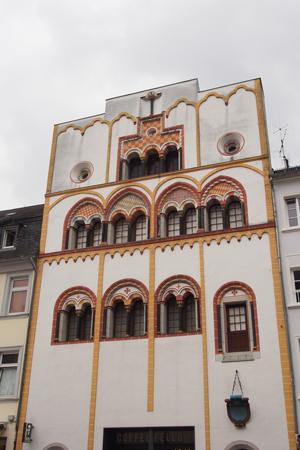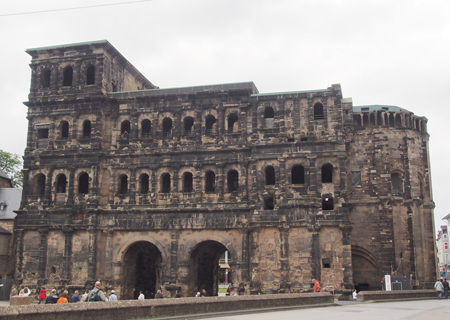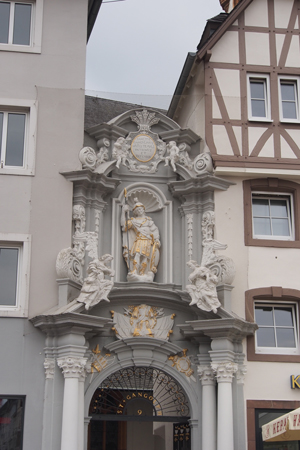Sat., 7/12/14 – Bernkastel
We arrived in Bernkastel during the night and this very small town might be the most beautiful on the Mosel. We took the town tour with Rebecca. She pointed out the building that was once the station for the “wine booze train.” The town is surrounded by vineyards so this is a wine town with many wine tasting shop. We looked at the high water marks on a house in one of the squares. Water was about 12 feet high in town on 2/28/1789. St. Michaels Church was built in 1787 and includes an older former watchtower.
Family of Egyptian geese |
Street scene and coat of arms flag
|
Mosaic coat-of-arms for Kues (across the river)
|
Mosaic coat-of-arms for Bernkastel |
Map of Mosel wine region
|
|
High water marks - they have had some serious floods here
|
We looked at the Doctor Fountain. At sometime in the past in the 20th c. a doctor, Dr. Hermann Schroeder, brought 33 ill people (33 was the number of years Christ lived) to see if the medicinal quality of the wine of this region would cure them.
|
Decorated half-timbered wall |
Doctor Fountain in Hermann-Schroeder Platz
|
Street scene
|
Market square |
In the market square is a fountain of Archangel Michael from 1606 and the Rathaus, built in 1608. On an outside wall are wrist manacles on chains. People who broke a law would be chained outside the Rathaus for people to throw eggs or rotten fruit at them. The houses surrounding this square are the prettiest we have seen. They are decorated with paint and flowers and line the crooked streets. From the square we could see the Spitzhaus called the pointed house. How much tax you paid was based on the frontage of your house. This one has very little frontage. Since this town is Bernkastel, or bear castle, there is a fountain with two bears. There have been no bears here for 300 years but it is the thought that counts!
|
Archangel Michael Fountain
|
Wrist manacles on chains |
Rathaus
|
Spitzhaus
|
Bear Fountain |
Street scene |
|
We have seen many “Schmuck” stores in all of the towns. Schmuck means jewelry! |
Grancher Tor - Town Gate
|
We walked under the Grancher Tor – the gate out of town leading to the town of Grancher. Around the corner we entered the Doktorkeller, a wine cellar in a cave. This winery cave is 360 years old and was originally used to store ice. We had a taste of four wines made there and were given a lesson on wine. The Doctor Vineyard is 125 years old. In the Mosel region the vines grow in shale. The shale retains the sun’s heat and there is plenty of moisture. Ninety-five% of Mosel wine is exported and 65% goes to the US. During WWII one tunnel of the cave was sealed off so the Germans did not destroy the wine in it. When it was finally rediscovered and opened the wine was still good. One bottle from 1921 was sold at Christies Auction for $11,500.
|
|
Doktorkeller Wine Cellar
|
Doktorkeller Wine Cellar |
After lunch Rebecca took about 20 of us on a hike up to the ruins of the Castle of Landshut on a hill overlooking Bernkastel and Kues and the Mosel. We walked straight up on a path with lots of steps. The views from the castle were great. The tower was under reconstruction so we could not climb it but we could still see all of the river valley with vineyards on every slope.
|
|
Landshut Castle
|
Landshut Castle |
The Mosel from Landshut Castle
|
Vineyards from Landshut Castle |
The return trip down was on a path through the woods that went past a vineyard chapel (pray for a good harvest) and a narrow waterfall and past the two-sided crucifix – Jesus is looking to heaven on one and down to earth on the other. We just got back on the ship in time for it to sail.
|
|
Waterfall
|
Stored wood |
Two-sided crucifix
|
Two-sided crucifix
|
The captain told us he was about to take the ship under a very low bridge so we went up top to see the canvas sun shade, glass room, and wheelhouse all collapsed and we went under a bridge we could have touched.
|
|
|
|
Sun., 7/13/14 – Trier
Our ship moved from quiet Issel to a dock at Trier where a wine and beer festival was taking place. It is crowded and noisy. We are docked between the public toilet trailer and the sound stage. The amped bass makes the boat vibrate! Thank goodness we are moving further up the Mosel at 9:30 tonight.
We were shuttled by bus into the old town for a city tour of Trier with a local guide. We started our tour standing outside the huge Basilica, the tower of which is 33 meters high. The walls are made with clay bricks that were originally plastered (stucco) and painted. The windows are panes of alabaster. Attached to the side of the basilica is the Rococo Palace of the Archbishop. It now houses the education administration. At the first level are statues of children representing the four seasons. At the very top is Pomona, the goddess of gardens. She looks out on a park with flowers, fountains and tree lined gravel paths. It was pretty.
Basilica of Constantine
|
Basilica of Constantine |
Prince Elector’s Palace
|
Gardens at the Prince Elector’s Palace |
Next we walked into the cathedral district of the town. The Catholic Church owned all of the buildings within. On our way to the Cathedral and Our Lady Church there was a replica of a statue in the museum of a Roman ship with oars filled with wine casks. There are 28 Catholic churches and only two Protestant churches in Trier. In this district are two Catholic churches side by side – the Trier Cathedral (St. Peter's) and Our Lady Church (Liebfrauenkirche). After lunch we went inside both churches. The cathedral is huge and impressive. Above the high altar is another chapel, the Shrine of the Holy Robe of Christ. It was built in the 17th c. while the main sanctuary was built by Romans in the 4th c. The Church of Our Lady was built in the 14th c. and is built in a unique rose shape instead of a cross shape. The main altar is in the center and the windows are abstract stained glass. These churches were awesome.
|
|
Church of Our Lady |
Windows in the Church of Our Lady
|
Roman ship statue |
St. Peter's Cathedral
|
We left the cathedral district and entered the main square. Between two of the shops is a fancy gateway that leads to St. Gangolf’s Church. It was relatively plain with some designs painted on the walls and ceiling. |
|
Hanging carillon
|
|
Half-timbered buildings |
Paranoid owner with the entry door on the second floor
|
Porta Negra
|
Tower of St. Gangolf's Church
|
Entrance to St. Gangolf’s Church
|
St. Gangolf’s Church |
After lunch we took the shuttle bus back to see more of Trier. We went into the churches and then walked to the Rheinisches Landes Museum of Trier. We did not get there before the heavens opened up with a vengeance. We ducked inside the Kaiser Thermal Baths Lobby until it let up a little and then visited the archaeological museum. (They gave us the senior discount of 4 Euros. Not all places give senior discounts to foreigners.) This was a wonderful museum of archaeological finds from north of the Alps (no photos, of course). The exhibits began with finds from the Ice Age and continued through the end of the 30-Years War. As we entered each room of a new era there was a plaque about the era written in German, English, and French. All the other information and signs were only in German but we did not care. The items on display were easy enough to identify and we could appreciate the condition they were in and their presentation. We especially admired the complete mosaic patterned floors from ruins uncovered in France, Germany, or Belgium. Trier is very rich in history and well documented.
We waited again for the heavy rain to slow up and then walked back to Porta Nigra and were happy to sit and wait in our shuttle bus. Back at the dock the carnival or fest was in full swing even in the rain.
| Return to Top | Return to Itinerary | Return to Trips page to view other trips | Return to Dreamcatcher Home Page |
